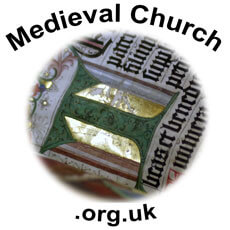Theology on the Web helps over 2.5 million people every year to find high quality theological resources that will help to equip them to serve God and to know Him better (2 Timothy 2:15). Like other websites that provide free services, it is dependent on donations to enable it to grow and develop and only 0.004% of visitors currently do so. If you would like to support this site, please use one of the options to the right of this message.
Synopsis
The first crusade (1096-99) was led by Godfrey of Bouillon,
Duke of Lorraine; Hugh of Vermandois, a brother of the king of France; Robert,
Duke of Normandy, a son of William the Conqueror; Bohemund of Tarent; and
Tan-cred of Hauteville, the son and the nephew of Robert Guiscard, etc. The
powerful address of Urban II., delivered to an enormous audience at Clermont in
November, 1095, and answered with an unanimous "God will it!" may be
con-sidered as the real starting-point of the first crusade. The organization
of so huge an enter-prise was, of course, slow and difficult. Aug. 15, 1096,
was fixed as the day on which the armies should begin to move. But people could
not wait. One swarm started in March under Peter the Hermit, another a little
later under Walter the Penniless, a third under Gottschalck; but all these swarms, after committing
horrible excesses and crimes, melted away under the resist-ance and punishment
of the Magyars, the Slavs, and the Greeks. The regular armies, moving by sea
and by land, united in Constantinople in the last days of 1096; and June 24,
1097, Nicaea was captured; but Antioch was not taken until June 3, 1098; and
Jerusalem not until July 15, 1099. All the Jews in the city were burnt alive in
the synagogue: all the infidels - some say seventy thousand - were massacred.
Through the desolate streets the victors went in a proces-sion to the Church of
the Resurrection, singing their hymns, and wading in blood. Shortly after, the
kingdom of Jerusalem was established, and Godfrey was made king. The sources to
the history of the first crusade, reports by eyewit-nesses and contemporaries
(among which the Historia de Hierosolyma, by William of Tyre, is the
most important), are collected in Bongarius: Gesta Dei per Francos,
Hanover, 1611.
Philip Schaff, ed., A Religious
Encyclopaedia or Dictionary of Biblical, Historical, Doctrinal, and Practical
Theology, 3rd edn, Vol. 1. Toronto, New York & London: Funk &
Wagnalls Company, 1894. pp.576-77.
Secondary Sources
 |
E.O. Blake,
"A Hermit Goes to War: Peter and the Origins of the First Crusade," W.J.
Shiels, ed., Monks, Hermits and the Ascetic Tradition. Studies in Church
History, Vol. 21. 1984. pp.79-107. |
 |
Marcus Bull,
"The Roots of Lay Enthusiasm for the First Crusade," History 78 (1993):
353-72. |
 |
Robert
Chazan, European Jewry and the First Crusade. Berkeley,
1987. |
 |
 John France, Victory in the East: A
Military History of the First Crusade. Cambridge: Cambridge University
Press, 1996. Pbk. ISBN: 0521589878. pp.441. John France, Victory in the East: A
Military History of the First Crusade. Cambridge: Cambridge University
Press, 1996. Pbk. ISBN: 0521589878. pp.441. |
 |
 A.C.
Krey, The First Crusade. Princeton & London: Princeton University
Press, 1921. Reprinted: Eugene, OR: Wipf & Stock. ISBN: 978-1725218321. pp.318. [Sign-up to Perlego and access book instantly] A.C.
Krey, The First Crusade. Princeton & London: Princeton University
Press, 1921. Reprinted: Eugene, OR: Wipf & Stock. ISBN: 978-1725218321. pp.318. [Sign-up to Perlego and access book instantly] |
 |
 F. Donald Logan, A History of the Church
in the Middle Ages. London & New York: Routledge, 2002. Pbk. ISBN:
0415132894. pp.118-128. [Sign-up to Perlego and access book instantly] F. Donald Logan, A History of the Church
in the Middle Ages. London & New York: Routledge, 2002. Pbk. ISBN:
0415132894. pp.118-128. [Sign-up to Perlego and access book instantly] |
 |
 Thomas F. Madden, A Concise
History of the Crusades. Rowman and Littlefield Publishers Inc., 2000. Hbk.
ISBN: 0847694291. pp.17-37. Thomas F. Madden, A Concise
History of the Crusades. Rowman and Littlefield Publishers Inc., 2000. Hbk.
ISBN: 0847694291. pp.17-37. |
 |
Robert
L. Nicholson, Tancred. A Study of his Career and Work in their Relation to
the First Crusade and the Establishment of the Latin States in Syria and
Palestine. AMS Press, 1978. Hbk. ISBN: 0404154255. |
 |
 Jonathan Riley-Smith, The First Crusade
and the Idea of Crusading. Pennsylvania State University Press, 1986. .
ISBN: 0812213637. Reprinted: London: Continuum, 2003. ISBN: 9780826484314. pp.240. [Sign-up to Perlego and access book instantly] Jonathan Riley-Smith, The First Crusade
and the Idea of Crusading. Pennsylvania State University Press, 1986. .
ISBN: 0812213637. Reprinted: London: Continuum, 2003. ISBN: 9780826484314. pp.240. [Sign-up to Perlego and access book instantly] |
 |
 Steven Runciman, A History of the
Crusades, Vol. 1: The First Crusade. Harmonsworth: Penguin Books,
1991. Pbk. ISBN: 0140137068. pp.400. Steven Runciman, A History of the
Crusades, Vol. 1: The First Crusade. Harmonsworth: Penguin Books,
1991. Pbk. ISBN: 0140137068. pp.400. |
 |
 G.S.M. Walker, The Growing Storm. Sketches of Church History from A.D. 600 to A.D. 1350. London: The Paternoster Press, 1961. Hbk. pp.252. G.S.M. Walker, The Growing Storm. Sketches of Church History from A.D. 600 to A.D. 1350. London: The Paternoster Press, 1961. Hbk. pp.252.  pdf [All reasonable efforts have been made to contact the copyright holder of this article without success. If you hold the rights, please contact me] pdf [All reasonable efforts have been made to contact the copyright holder of this article without success. If you hold the rights, please contact me] |
Related Subjects
 John France, Victory in the East: A
Military History of the First Crusade. Cambridge: Cambridge University
Press, 1996. Pbk. ISBN: 0521589878. pp.441.
John France, Victory in the East: A
Military History of the First Crusade. Cambridge: Cambridge University
Press, 1996. Pbk. ISBN: 0521589878. pp.441.  A.C.
Krey, The First Crusade. Princeton & London: Princeton University
Press, 1921. Reprinted: Eugene, OR: Wipf & Stock. ISBN: 978-1725218321. pp.318. [Sign-up to Perlego and access book instantly]
A.C.
Krey, The First Crusade. Princeton & London: Princeton University
Press, 1921. Reprinted: Eugene, OR: Wipf & Stock. ISBN: 978-1725218321. pp.318. [Sign-up to Perlego and access book instantly] F. Donald Logan, A History of the Church
in the Middle Ages. London & New York: Routledge, 2002. Pbk. ISBN:
0415132894. pp.118-128. [Sign-up to Perlego and access book instantly]
F. Donald Logan, A History of the Church
in the Middle Ages. London & New York: Routledge, 2002. Pbk. ISBN:
0415132894. pp.118-128. [Sign-up to Perlego and access book instantly] Thomas F. Madden, A Concise
History of the Crusades. Rowman and Littlefield Publishers Inc., 2000. Hbk.
ISBN: 0847694291. pp.17-37.
Thomas F. Madden, A Concise
History of the Crusades. Rowman and Littlefield Publishers Inc., 2000. Hbk.
ISBN: 0847694291. pp.17-37. 
 Jonathan Riley-Smith, The First Crusade
and the Idea of Crusading. Pennsylvania State University Press, 1986. .
ISBN: 0812213637. Reprinted: London: Continuum, 2003. ISBN: 9780826484314. pp.240. [Sign-up to Perlego and access book instantly]
Jonathan Riley-Smith, The First Crusade
and the Idea of Crusading. Pennsylvania State University Press, 1986. .
ISBN: 0812213637. Reprinted: London: Continuum, 2003. ISBN: 9780826484314. pp.240. [Sign-up to Perlego and access book instantly] Steven Runciman, A History of the
Crusades, Vol. 1: The First Crusade. Harmonsworth: Penguin Books,
1991. Pbk. ISBN: 0140137068. pp.400.
Steven Runciman, A History of the
Crusades, Vol. 1: The First Crusade. Harmonsworth: Penguin Books,
1991. Pbk. ISBN: 0140137068. pp.400. G.S.M. Walker, The Growing Storm. Sketches of Church History from A.D. 600 to A.D. 1350. London: The Paternoster Press, 1961. Hbk. pp.252.
G.S.M. Walker, The Growing Storm. Sketches of Church History from A.D. 600 to A.D. 1350. London: The Paternoster Press, 1961. Hbk. pp.252. 










